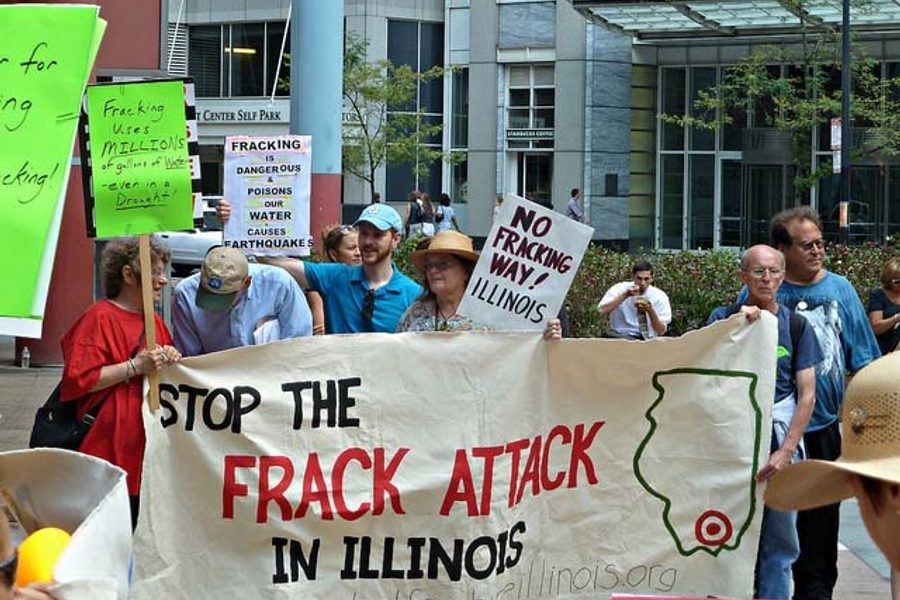To Frack or Not to Frack in Illinois
New legislation that will regulate fracking in the state has divided environmentalists.
Marla Donato and students of DePaul University

This story was compiled by Marla Donato, journalism instructor at DePaul University, and includes reporting by students Monica Carter, Karina T. Illescas, Samantha A. Jacobs, Brianna R. Kelly and Aziza Khamitova.
When the governors visiting Chicago for the Democratic Governors Association meeting arrive at Wrigley Field Tuesday night, they can expect to be greeted with more than hot dogs and a Cubs game. The Midwest office of Food and Water Watch has organized a demonstration for 5:30 p.m. near the Wrigley View Rooftop, the Waveland Avenue venue for the gubernatorial group’s pre-game reception, to protest the state legislature’s recent passage of the Hydraulic Fracturing Regulatory Act — a measure fracking opponents say is a sorry substitute for an all-out ban or moratorium on the controversial practice.
“This is a vital opportunity to show these Democratic governors and others around the country who are making critical decisions on fracking… that we do not want fracking in our country,” says Emily Carroll, the midwest region director of Food and Water Watch.
The Hydraulic Fracturing Regulatory Act has received the endorsement of Illinois Gov. Pat Quinn, a Democrat, who said he “looks forward to signing the legislation” that both chambers of the Illinois General Assembly passed by wide margins at the end of the spring session.
Hydraulic fracturing, or “fracking,” is a process that removes natural gas deposits trapped underground in dense shale rock. Water mixed with chemicals and sand or gravel is pumped through deep wells into the shale layers. The high pressure causes the shale to crack, thus releasing natural gas. The mixture is then pumped back up to the surface.
“I applaud the members of the Illinois General Assembly for passing the nation’s strongest environmental protections when it comes to hydraulic fracturing,” Quinn said in a May 31 statement shortly after its passage. “This legislation will open the door for thousands of jobs and significant economic development in Southern Illinois… It’s the result of a good-faith effort by lawmakers, industry and labor leaders, environmental groups and members of my administration to ensure Illinois’ natural resources are protected.”
But opponents view the bill as a smoke-and-mirror attempt to make an inherently unsafe practice appear less dangerous. They fear it will transform rural areas into toxic wastelands and permanently remove from the hydrological cycle millions of gallons of water from communities and farms in an already drought-ravaged state. Annette McMichael, a spokeswoman for Southern Illinoisans Against Fracturing Our Environment (SAFE), says the group was “horrified” by the bill’s passage, arguing that fracking has the potential to contaminate the drinking water of residents. SAFE is part of the Illinois Coalition for a Moratorium on Fracking, which charges that the bill had been “negotiated behind closed doors, and was not based on scientific study, but rather on the question of what was politically possible.”
Illinois is the latest state to grapple with a rapidly expanding natural gas fracking industry, due in part to newer, more agressive and intrusive techniques that include high-volume horizontal fracturing, which forces millions of gallons of chemical-laced water at much higher pressure through vertical tunnels that can now bend and travel horizontally for up to two miles. Much of the fracking in the United States is undertaken with little to no regulation, since fracking is exempt from many federal regulations, including the Clean Air and Clean Water Acts. In addition, fracking is also exempt from water usage regulations in many states. The Illinois bill could serve as a legislative model, as lawmakers in some other states are scrambling to regulate this drilling process, sometimes long after oil drills have been sunk.
Supporters of the Illinois bill insist it offers the nation’s strongest regulations, since it was hammered out over months in an unusual series of meetings between lawmakers and representatives from state agencies, labor, industry and environmental groups, including the Sierra Club, Natural Resources Defense Council, Environmental Law and Policy Center, Illinois Environmental Council and Faith in Place.
“It is very rare that environmentalists are offered an opportunity at this level to craft such a law,” says Allen Grosboll, co-legislative director & senior policy advocate for the Chicago-based Environmental Law and Policy Center. “While the bill is not a moratorium, it does at least give the state significant regulatory power and provides significant public input and even authorizes citizen lawsuits.”
The unusual bill-crafting process has fractured the environmental community. In a statement released after the bill’s passage, SAFE said the environmental organizations that helped negotiate the bill “do not represent us nor are they empowered to negotiate on our behalf…. No comprehensive health study or environmental impact study was ever commissioned. No public hearings… ever took place.”
Those opponents also dispute the claim that the Illinois bill offers the most protections in the nation, pointing to Vermont, which has banned the practice, and North Carolina and New York, which have put moratoriums in place. Outside the United States, fracking moratoriums have been issued in Germany and Northern Ireland, and France and Bulgaria have banned it outright — despite the fact that these countries have the largest shale-gas reserves in Europe.
Absent a moratorium, strong regulations in Illinois were necessary because operators have bought leases to frack on more than a quarter million acres in the state, says Nick Magrisso, a policy advocate for the Midwest Program of the Natural Resources Defense Council (NRDC). Before the regulatory law takes effect, any fracking operator can apply for a $100 permit and expect to receive permission to drill within days, says Magrisso.
Grosboll concurs. “The gates are already wide open,” he says. “We have had vertical fracking for decades in Illinois and limited horizontal fracking for many years. The reason no one can point to large-scale fracking in Illinois is that our laws are so weak, (and without the bill) the industry… doesn’t even have to tell us what they are doing or planning to do.”
Grosboll adds it would have been “irresponsible and harmful” to boycott the bill negotiation process and “allow the industry to frack in Illinois with no regulations and no public scrutiny.”
But opponents to the bill say Illinois’ economic woes will mean regulatory agencies will be pared down too much to be effective. “Illinois state government is broken,” McMichael says. “They can’t regulate anything. The DNR [Department of Natural Resources] is so understaffed they can barely function. I have absolutely no reason to believe that fracking will ever be monitored.”
At the heart of the debate are the potential risks associated with the process. The flow-back water that comes back out of the hole includes oil, chemicals and sometimes naturally occurring radioactive materials, according to Dr. James Montgomery, associate professor in the College of Science and Health at DePaul University. Some of the contaminated water remains underground in the now-more-porous rock beds, and typically the contaminated water pumped up to the surface is left in open-air pits. In addition, the drilling typically takes place through casings of steel and cement that go directly through or near drinking aquifers because a large quantity of water is necessary for the process. Well bores are lined with metal casing. If the well bore passes through a drinking water aquifer, and if the casing is not properly cemented in place, then it is possible that methane gas and other fluids can migrate through cracks in the cement and enter the aquifer.
Leaks also can vent large amounts of methane into the atmosphere, since natural gas contains a large amount of that powerful greenhouse gas. And diesel trucks and machinery can contribute to air pollution.
Because regulations are slim to non-existent in many states, natural gas drilling operators are not required to disclose the toxic chemicals they are pumping underground near water sources. The hundreds of fracking chemicals that are often used are “known carcinogens or toxic chemicals that have consequences… things like benzene, toluene, ethylbenzene, those in the BTEX chemical family,” says Magrisso.
Studies on the impacts of fracking have started to appear in scientific journals, but because there has been scant disclosure of chemicals with little to no regulation or input from public health officials, it has been difficult to document its health effects.
However, one Colorado-based organization, the Endocrine Disruption Exchange, compiled a list of more than 300 chemicals used during natural gas operations. The group researches health problems caused by exposure to chemicals known as “endocrine disruptors,” which have been linked to diseases including cancer to diabetes. The exchange’s list of chemicals used during natural gas operations found that “more than 75% of the chemicals could affect the skin, eyes, and other sensory organs, and the respiratory and gastrointestinal systems. Approximately 40-50% could affect the brain/nervous system, immune and cardiovascular systems, and the kidneys; 37% could affect the endocrine system; and 25% could cause cancer and mutations.” The report noted this doesn’t take in account the chemicals that “may have long-term health effects that are not immediately expressed.”
Worker health is also an issue. “The silica sand used in fracking operations is carcinogenic and can lead to silicosis,” an irreversible debilitating lung disease, says Carroll of Food and Water Watch. Last year, the federal Occupational Safety and Health Administration (OSHA) issued a “hazard alert” that focuses on health hazards of worker exposures to silica in the air.
Kimberly Frye, an instructor in the College of Science and Health at DePaul University, also listed the potential of air pollution resulting from the release of volatile organic compounds, as well as reports of “seismic events.” Fracking has been linked to earthquakes in Ohio, and the scientific journal Geology recently published a joint study that showed a link between earthquakes in Oklahoma and the injection of contaminated fluids underground. This could be an issue in Illinois since the southern part of the state is near the New Madrid Seismic Zone, “the most active seismic area in the United States east of the Rocky Mountains,” according to the Missouri Department of Natural Resources.
Dr. Lora Chamberlain, a member of the moratorium coalition and a Chicago-based environmentalist and activist, says the coalition wanted the Illinois General Assembly to stop fracking until seeing the results of a study by the Geisinger Health System, a medical health service provider located in the region of Pennsylvania where fracking has been occurring. Preliminary reports are expected at the end of this year.
“This study, the largest in the country, will give us accurate numbers and a much better picture of the health impact,” says Chamberlain. “(We) had even offered to compromise with the Illinois General Assembly for a one-year moratorium, feeling that the Pennsylvania health study was the predominant report that we needed for them to make an educated decision.”
New York Gov. Andrew Cuomo has postponed making decisions on fracking until the release of the Geisinger study, according to a March 2013 Associated Press report. New York sits atop the massive Marcellus Shale Deposit that straddles several states, including Pennsylvania. New York has been the site of many contentious fracking battles with a growing movement by local governments to pass bans or moratoriums against horizontal hydraulic fracturing. The New York state Supreme Court ruled in May that the towns of Dryden and Middlefield can ban drilling within their borders.
The NRDC’s Magrisso says that the Illinois bill attempts to curb some of the health risks associated with fracking by including regulations for storage of wastewater in closed tanks and more disclosure of chemicals used. In addition, the regulations call for testing the area’s water before, during and after fracking. They also strengthen safeguards between drilling and drinking sites, and include a ban on the use of diesel on site, according to Magrisso.
“We won an awful lot — more so, realistically speaking, than any other state,” says Magrisso. “We still think there is going to be more that needs to come after passage. But we also realize, being pragmatic, that not having anything in place leaves us in a precarious and exposed position. It’s really hard for any one side to walk away and say, ‘We got everything we wanted.’ ”
Meanwhile, industry officials say fracking can be done safely.
“High-volume hydraulic fracturing is currently occurring in dozens of states and has been occurring safely for more than a decade,” says Mark Denzler, vice president and chief operating officer for the Illinois Manufacturers’ Association. “Even President Obama’s former EPA Administrator Lisa Jackson noted that fracturing can occur safely with proper regulation.”
Denzler says Illinois residents are amply protected and compared Illinois’ more than 90 pages of legislation to regulatory measures in other states that are only three to five pages long.
Chris McCloud, communications director of the Illinois Department of Natural Resources, forwarded a document that stated that the Illinois act “includes numerous precedent-setting provisions,” including disclosure requirements that will include “the creation of master lists of the base fluids, additives and chemicals that may be used in fracking, which are to be posted on the Illinois Department of Natural Resource’s website.” However, the “act allows companies to request trade secret protection of any of the chemical information,” which the public can then “challenge.”
Trade-secret chemicals were center-stage in the controversial 2011 Oscar-nominated documentary Gasland, which featured dramatic footage of a Colorado resident setting fire to a household water faucet. Denzler says the flaming tap in Colorado was caused by methane gas that was in the water prior to hydraulic fracturing and he disputed claims by opponents that fracking chemicals can disrupt the endocrine system and cause ailments such as cancer and Type 2 diabetes.
But fracking opponents in Illinois remain unconvinced and unimpressed by the safety claims of industry and lawmakers. Chamberlain’s group, Frack Free Illinois, called on Quinn to “immediately convene an independent task force (that includes public hearings) to look at the evidence of the devastating effects of fracking… [since] it is the public who are paying attention to the devastation from fracking around the country, and not our legislators.”

I hope you found this article important. Before you leave, I want to ask you to consider supporting our work with a donation. In These Times needs readers like you to help sustain our mission. We don’t depend on—or want—corporate advertising or deep-pocketed billionaires to fund our journalism. We’re supported by you, the reader, so we can focus on covering the issues that matter most to the progressive movement without fear or compromise.
Our work isn’t hidden behind a paywall because of people like you who support our journalism. We want to keep it that way. If you value the work we do and the movements we cover, please consider donating to In These Times.



